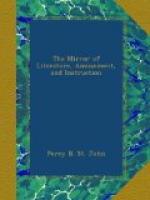Before I conclude, I ought, perhaps, to make some mention of the pretended nails of the passion, which were obtained by Constantine the Great at the same time with the cross. He melted a part of them into a helmet for himself; and the other part was converted into a bridle for his horse, in supposed obedience to a prophetic text of Zechariah: “In that day shall there be upon the bells (bridles) of the horses, holiness unto the Lord."[20] Yet, though the helmet alone might appear to have required all the nails which could possibly be employed in a crucifixion, it is not unusual in southern Europe to meet with fragments of old iron, for which the same sacred origin is claimed. Thus, for instance, at Catania, in Sicily, I have seen one of these nails, which is believed to possess miraculous powers, and exhibited only once a year with great solemnity. There is another in a private oratory of the Escurial; and I was surprised in observing in the same case a relic of Sir Thomas a Becket. All the nails, from the time of Constantine, are rejected as spurious by Cardinal Baronius;[21] yet a former Pope had expressed his belief in their authenticity;[22] and the ingenious idea of miraculous vegetation might have been easily applied to them. But to trace the other parts of this real or fabulous history, and more especially their insertion in the Iron crown of Lombardy, would require, though scarcely deserve, a separate essay.
[2] Read before the Royal
Society of Literature, but since altered
by
the author.
[3] For the discovery of the
cross, compare Theodoret, lib. i. c.
18;
Socrates, lib. i. c. 17; and Sozomen, lib. ii. c. 1,
&c.
[4] De Vita Constant, lib. iii. c. 33.
[5] St. Cyril ap. Baronium,
Annal. Eccles. A.D. 326, No. 50. One
whole
epistle of St. Paulinis of Nola (the eleventh) is also
devoted
to this subject.
[6] The participation of the
Jews is positively asserted by
Eutychius
(Annal. vol. ii. p. 212,) but doubted by Theophanes
(Chronograph,
p. 252:) [Greek: os phasi tines], are his words.
[7] Eutychius, Annal, vol. ii. p. 242-247.
[8] Ducange, Gloss. Med. Graec., p. 1437.
[9] Theophanes, Chronograph. p. 280.
[10] Baronius, Annal. Eccles. A.D. 643. No. 1-4.
[11] Bede, Op. vol. iii. p. 370. Ed. Colon. Agripp. 1688.
[12] Epist, lib. 7. indict, i. ep. 34.
[13] Nicephor. Constantinopolit. p. 20.
[14] Theophanes, Chronograph. p. 318.
[15] Chronicon Casinense, lib. iii. c. 55.
[16] There is some account of its
recovery by a Genoese, but it is
clouded with miracles. He walked over
the sea, as over dry
land, &c. See Muraturi, Dissert. 58.
vol. v. p. 10, ed. 1741.
[17] See Raynaldus, Aunual.
Eccles. A.D. 1217, No. 39, and Pagi,
Critic. A.D. 1187, No. 4.




